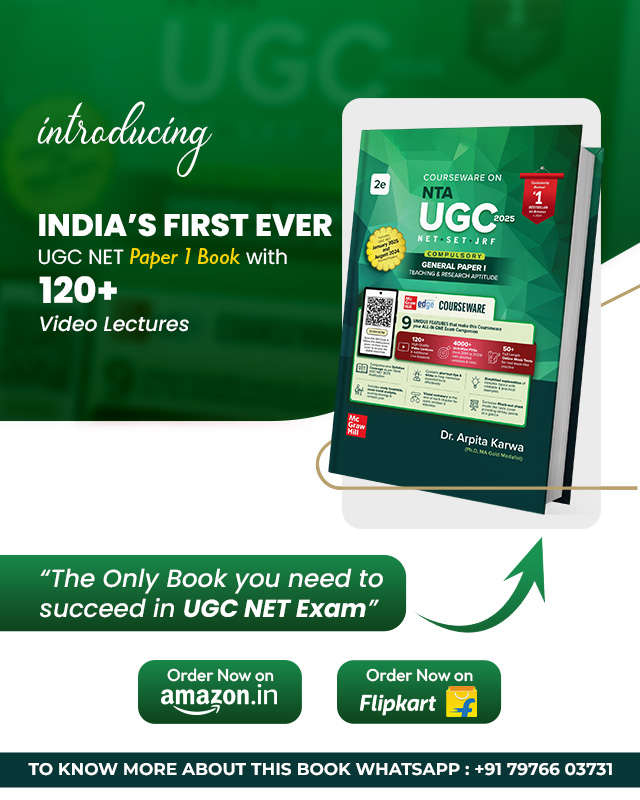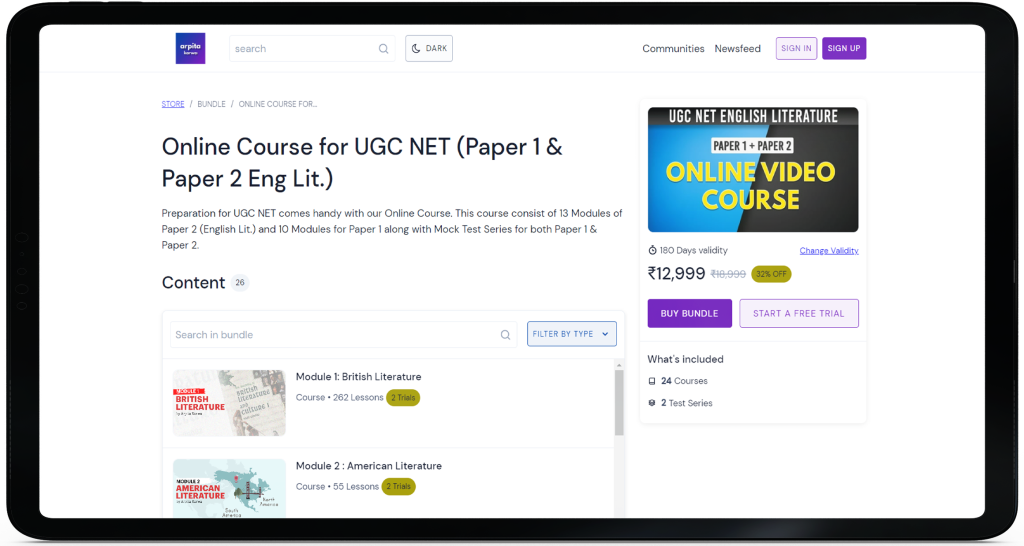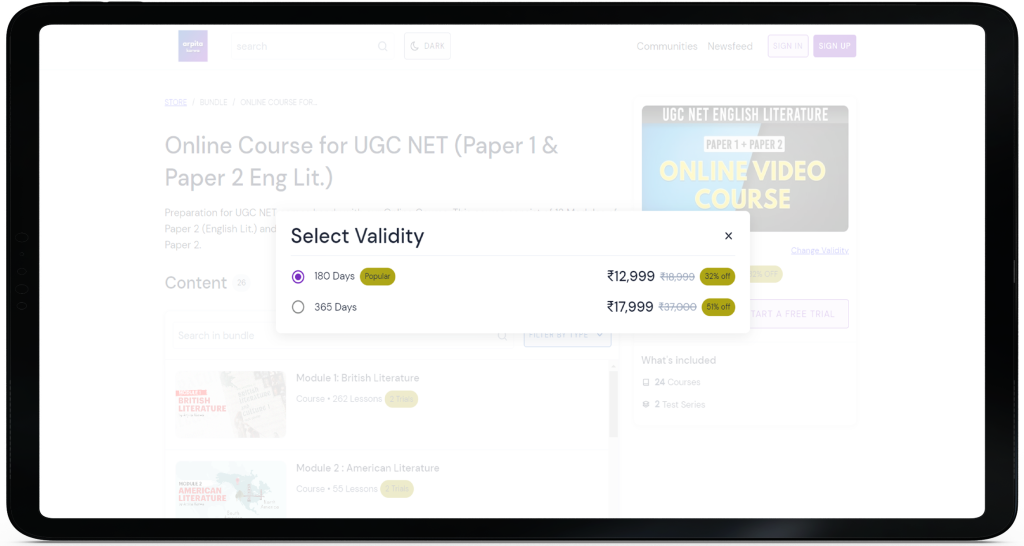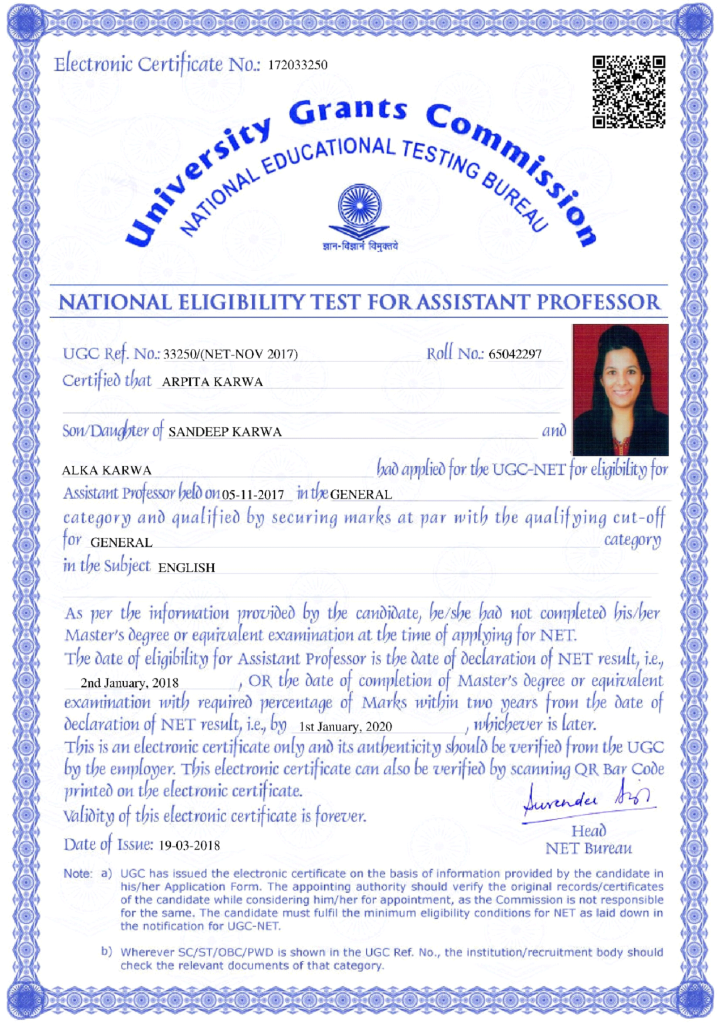UNIVERSITY OF DELHI M.A. ENGLISH, ENTRANCE EXAM 2018
June 19, 2023 2023-12-11 18:36UNIVERSITY OF DELHI M.A. ENGLISH, ENTRANCE EXAM 2018
University of Delhi M.A. English, Entrance Exam 2018
Q.1) Which one(s) of the following is/are true about Shakespeare’s Problem Plays?
(i) They explore ignoble aspects of human nature.
(ii) They deal with some moral problems.
(iii) They challenge generic categorisation.
(iv) The resolution of the plot seems to be problematic in these plays.
[1] (i) & (ii)
[2] Only (iv)
[3] (ii), (iii) & (iv)
[4] All of these
Answer: All of these
Q.2) Which of the following is/are true about Shakespeare’s major tragic characters?
(A) Complex and capable of surprising us
(B) Develop throughout the play
(C) Deep mutual relation and claim our sympathy
(D) Come to a realisation by the end of the play
[1] (A), (B) & (C)
[2] (A), (B) & (D)
[3] All of these
[4] (B), (C) & (D)
Answer: All of these
Q.3) A doodle means a
[1] slogan on a wall
[2] line drawing made to invoke laughter
[3] rough drawing made absent-mindedly
[4] doddering person
Answer: rough drawing made absent-mindedly
Q.4) Identify the wrong combination of author and book.
[1] White Tiger – Hanif Qureshi
[2] For Whom the Bells Tolls – Ernest Hemingway
[3] Of Mice and Men – John Steinbecko
[4] The Inheritance of Loss – Kiran Desai
Answer: White Tiger – Hanif Qureshi
Q.5) One feature that we easily notice about Shakespeare’s tragedies is their verbosity, because:
(i) Tragedy comes with an unspeakable element
(ii) Its characters struggle for meaning
(iii) The characters are charismatic speakers
(iv) They address fundamental problems of human experience
[1] All of these
[2] (i), (ii) & (iii)
[3] (i), (ii) & (iv)
[4] (ii), (iii) & (iv)
Answer: All of these
Q.6) In Elizabethan play, a Machiavelli character is:
(i) A stage villain, full of cunning, calculation, wickedness and selfishness
(ii) A character threatening to create political chaos and disorder
(iii) A historical figure
(iv) A pupil of Machiavelli
[1] (i) & (ii)
[2] All of these
[3] (ii) & (iii)
[4] (iii) & (iv)
Answer: (i) & (ii)
Q.7) What is the concept of negritude?
[1] It was introduced to postcolonial studies by Edward Said
[2] It was introduced to postcolonial studies by Franz Fanon
[3] It linked black people across Africa, the Caribbean and the USA around a set of humanist values that were supposedly held by the black’s world over
[4] It seeks to study the experiences of blacks in colonial powers
Answer: It seeks to study the experiences of blacks in colonial powers
Q.8) What is the study of poetic meter and form called?
[1] Eulogy
[2] Tautology
[3] Prosody
[4] Rhetoric
Answer: Prosody
Q.9) Realism stands for…
(1) A literary movement in 19th C
(ii) A mode to represent life and experience in literature
(iii) The depiction of subject with scientific objectivity
(iv) The depiction of life as it really is
[1] (i), (ii) & (iv)
[2] (i), (ii) & (iii)
[3] All of these
[4] (ii), (iii) & (iv)
Answer: (i), (ii) & (iv)
Q.10) Arrange the art history periods in the correct sequence:
(i) Renaissance
(ii) Medieval
(iii) Baroque
(iv) Mannerism
[1] (i), (iv), (iii), (ii)
[2] (ii), (iv), (i), (iii)
[3] (ii), (i), (iii), (iv)
[4] (ii), (i), (iv), (iii)
Answer: (ii), (iv), (i), (iii)
Q.11) Assertion (A): Lyric poetry expresses the thoughts and feelings of the poet and is at times contrasted with narrative poetry and verse drama, which relate events in the form of a story.
Reason (R): Charlotte Bronte’s Jane Eyre relates events in the form of a story and therefore is a perfect example of a lyric poetry.
[1] Both (A) and (R) are true
[2] (A) is false and (R) is true
[3] Both (A) and (R) might be true and (A) is the correct explanation for (R)
[4] Both (A) and (R) might be true, but (A) is not the correct explanation for (R)
Answer: Both (A) and (R) might be true, but (A) is not the correct explanation for (R)
Q.12) Plato’s Republic introduces the principle of specialization- ‘The result, then, is that more plentiful and better-quality goods are more easily produced if each person does one thing for which he is naturally suited, does it at the right time, and is released from having to do any of the others’.
The above principle of specialisation refers to the principle that…
[1] everyone does that to which their nature best suits them, and not meddle in any other business.
[2] everyone does that to which their nature best suits them and interfere in other trades as well.
[3] everyone should act against his/her nature to diverge themselves but should not meddle in any other business.
[4] everyone should act against their nature to diverge themselves and interfere in other trades.
Answer: everyone does that to which their nature best suits them, and not meddle in any other business
Q.13) Match List-i with List-ii and choose the appropriate option from the codes given below:
List-I
(A) The world is my oyster
(B) The vines wove their delicate fingers together
(C) My mouth was as dry as a bone
(D) You snore louder than a freight train!
List-II
(i) Simile
(ii) Hyperbole
(iii) Metaphor
(iv) Personification
Codes:
[1] A-i, B-ii, C-iii, D-iv
[2] A-iii, B-iv, C-i, D-ii
[3] A-ii, B-iv, C-iii, D-i
[4] A-iv, B-ii, C-i, D-iii
Answer: A-iii, B-iv, C-i, D-ii
Q.14) Fill in the blank with the appropriate option:
_______is an avant-garde movement, based primarily in France, that seeks to break down the boundaries between rational and irrational conscious and unconscious, through a variety of literary and artistic experiments.
[1] Existentialism
[2] Surrealism
[3] Magic Realism
[4] Atheism
Answer: Surrealism
Q.15) Match List-i with List-ii and choose the appropriate option from the codes given below:
List-I
(A) Prima facie
(B) Carte blanche
(C) Carpediem
(D) Vox Populi
List-II
(i) Public opinion
(ii) Accepted as so until proven otherwise
(iii) Unlimited authority
(iv) Seize the day
Codes:
[1] A-iii, B-iv, C-i, D-ii
[2] A-i, B-ii, C-iv, D-iii
[3] A-ii, B-iii, C-iv, D-i
[4] A-i, B-iv, C-iii, D-ii
Answer: A-ii, B-iii, C-iv, D-i
Q.16) Match List-i with List-ii and choose the appropriate option from the codes given below:
List-I
(A) Samuel Taylor Coleridge
(B) William Blake
(C) P.B. Shelley
(D) William Combe
List-II
(i) Auguries of Innocence
(ii) Ozymandias
(iii) The Tour of Doctor Syntax
(iv) Christabel
Codes:
[1] A-i, B-ii, C-iii, D-iv
[2] A-iii, B-ii, C-iv, D-i
[3] A-iv, B-iii, C-ii, D-i
[4] A-iv, B-i, C-ii, D-iii
Answer: A-iv, B-i, C-ii, D-iii
Q.17) Match List-i with List-ii and choose the appropriate option from the codes given below:
List-I
(A)One Part Woman
(B)The Gypsy Goddess
(C)Untouchable God
(D)Unclaimed Terrain
List-II
(i) Ajay Navarian
(ii) Kancha Illaiah
(iii) Perumal Murugan
(iv) Meena Kandasamy
Codes:
[1] A-iv, B-iii, C-i, D-ii
[2] A-iii, B-iv, C-ii, D-i
[3] A-i, B-iv, C-iii, D-ii
[4] A-ii, B-iii, C-iv, D-i
Answer: A-iii, B-iv, C-ii, D-i
Q.18) “The end of a work of art is simply to exist in its formal perfection, that is, to be beautiful and to be contemplated as an end in itself.” Based on this statement certain inferences are given below. Identify the ones which completely approximates with this statement.
(i) This statement stresses on the from of the work, hence this can be read as a mouthpiece of formalistic criticism
(ii) This statement has similarities to the rallying cry of Aestheticism which is also called “1’art pour 1’art” (Art for Art’s sake)
(iii) This statement stresses the religion of beauty as posited by Flaubert and Mallarme
(iv) This statement anticipates the theory of the New Critics which highlight the autonomy and the artistry of a work of art
[1] Only (ii) & (iii)
[2] None of these
[3] All of these
[4] Only (i) & (iv)
Answer: Only (ii) & (iii)
Q.19) Match List-i with List-ii and choose the appropriate option from the codes given below:
List-I
(A) Bharat
(B) Anandvardhan
(C) Bhartrhari
(D) Kuntak
List-II
(i) Vakroktijivita
(ii) Vakyapadeeya
(iii) Natyashastra
(iv) Dhvanyaloka
[1] A-iv, B-iii, C-ii, D-i
[2] A-iii, B-ii, C-iv, D-i
[3] A-iii, B-iv, C-ii, D-i
[4] A-ii, B-iii, C-i, D-iv
Answer: A-iv, B-iii, C-ii, D-i
Q.20) Read the passage given below and fill in the blanks with the appropriate sequence of sentences.
Forster’s lifelong refusal to permit his novel to be filmed begins to look rather sensible. But once a revisionist enterprise gets under way, the mere wishes of a dead novelist provide no obstacle………. .
The continuing decline, the growing poverty and the meanness of spirit of much of Thatcherite Britain encourages many Britons to turn their eyes nostalgically to the lost hour of their precedence. The recrudescence of imperialist ideology and the popularity of Raj fictions put one in mind of the phantom twitching’s of an amputated limb.
………..in which it begins once again to strut and posture like a great power while in fact its power diminishes every year. The jewel in the crown is made, these days, of paste.
(A) And there can be little doubt that in Britain to day the refurbishment of the Empire’s tarnished image is underway.
(B) ‘Let’s Take the “Great” out of Britain’, that the idea of a Great Britain (originally just a collective term for the countries of the British Isles, but repeatedly used to bolster the myth of national grandeur) has bedevilled the actions of all post-war governments.
(C) Britain is in danger of entering a condition of cultural psychosis.
(D) But it was Margaret Thatcher who, in the euphoria of the Falklands victory, most plainly nailed her colours to the old colonial mast, claiming that the success in the South Atlantic proved that the British were still the people ‘who had ruled a quarter of the world.’
[1] (A) & (D)
[2] (B) & (C)
[3] (A) & (C)
[4] (A) & (B)
Answer: (B) & (C)
Q.21) Arrange the sentences P, Q, R, S given below in the appropriate order It is the…….
P. As the reader uses various perspectives offered to him by the text in order to relate the patterns and the “schematised views”. to one another, he sets the work in motion, and this very process results ultimately in the awakening of responses within himself.
Q. Virtuality of the work that gives rise to its dynamic nature, and this in turn is the precondition for the effects that work calls forth.
R. That this is no new discovery is apparent from references made even in the early days of the novel.
S. Thus, reading causes the literary work to unfold its inherently dynamic character.
[1] PQRS
[2] SPQR
[3] RSQP.
[4] QPSR
Answer: QPSR
Q.22) Arrange the sentences P, Q, R, S given below in the appropriate order.
P. The infant girl also experiences herself as an identified with her mother, as does the infant boy.
Q. Because of her own gender identity, the mother identifies with her girl child more than with her boy child.
R. In relating to her daughter she uncon-sciously replays many of the ambiguities and identifications she experienced with her own mother.
S. The mother thus often tends to relate to her daughter more as an extension of herself than as a separate person.
[1] PQRS
[2] SPRQ
[3] QRSP
[4] RPQS
Answer: QRSP
Q.23) Read the passage given below and select the most appropriate option.
“As for being poisoned by a book, there is no such thing as that. Art has no influence upon action. It annihilates the desire to act. It is superbly sterile. The books that the world calls immoral are books that show the world its own shame.”
The speaker is implying that:
[1] Books are poisonous which sterilize the world
[2] Books are the most disgraceful form of art
[3] All of these
[4] Art cannot be either moral or immoral
Answer: Art cannot be either moral or immoral
Q.24) Fill in the blanks with the appropriate option from the choices given below.
In “Women’s Time” Julia Kristeva’s main………. appears to be that in a modern society, human history attempts to regulate human behaviour into a kind of……………, which implies a certain dogma that is limiting and oppressive. Kristeva believes that feminism is in a position of becoming like religion, with all the limits and………… . According to Kristeva, feminism is in danger, because it has become (or is becoming) too…….. and restrictive, and therefore must be replaced.
(i) Religion
(ii) Restrictions
(iii) Codified
(iv) Argument
[1] (i), (ii), (iii), (iv)
[2] (i), (iv), (ii), (iii)
[3] (i), (iii), (iv), (ii)
[4] (iv), (i), (ii), (iii)
Answer: (iv), (i), (ii), (iii)
Q.25) Fill in the blank with the appropriate option:
The combination of far-fetched circumstances with a terse moral suggests that this is a……….
[1] parable
[2] sermon
[3] folktale
[4] fable
Answer: parable
Q.26) Match List-i with List-ii and choose the appropriate option from the codes given bellow:
List-I
(A) Carnivalesque
(B) Difference
(C) Alienation effect
(D) Objective Correlative
List-II
(i) Eliot
(ii) Brecht
(iii) Derrida
(iv) Bakhtin
[1] A-i, B-ii, C-iii, D-iv
[2] A-iii, B-ii, C-iv, D-i
[3] A-iv, B-iii, C-ii, D-i
[4] A-iv, B-i, C-iii, D-ii
Answer: A-iv, B-iii, C-ii, D-i
Q.27) Fill in the blanks with the appropriate option from the choices given below:
Society, …………, and culture are three concepts whose meaning has changed recently, each change in one affecting the meaning of the other two as well. In short, each concept has conformed to a …………… model: society, for instance, previously referred to active fellowship or company but in a bourgeois context refers to “civil society,” or commercial society. The meaning of economy has changed from……… of household and community to the system of production, distribution, exchange, and ……… of modern capitalism.
(i) bourgeois
(ii) management
(iii) economy
(iv) consumption
[1] (i), (ii), (iii), (iv)
[2] (iv), (i), (iii), (ii)
[3] (ii), (iii), (iv), (i)
[4] (iii), (i), (ii), (iv)
Answer: (iii), (i), (ii), (iv)
Q.28) What is used as “vehicle” in the sentence “The camel is the ship of the desert.”
[1] Ship
[2] Camel
[3] Desert
[4] None of these
Answer: Camel
Q.29) In Shakespeare’s Romantic Comedies a significant number of characters of the subplot:
(i) come from the lower strata of society or behave like them
(ii) parody the main plot
(iii) wittingly/unwittingly help to sort out the problem of the characters in the main plot
(iv) interacts with main plot at the end where everyone joins the celebrations
[1] (i) & (ii)
[2] (iii) & (iv)
[3] (ii) & (iii)
[4] All of these
Answer: All of these
Q.30) Which of the following are the substance of “Shakespearean Tragedy”?
(i) It is a story of a single man of high stature.
(ii) He has some tragic flaw, and acts as an agent of tragedy.
(iii) He is subjected to unusually intense suffering.
(iv) The last act results in the catastrophe that brings death to the major characters.
[1] All of these
[2] (i), (ii) & (iii)
[3] (i), (ii) & (iv)
[4] (ii), (iii) & (iv)
Answer: All of these
Q.31) Fill in the blank with the appropriate option:
…………is a genre of late-18th-century literature that featured brooding, mysterious settings and plots and set the stage for what we now call “horror stories.” Horace Walpole’s The Castle of Otranto, set inside a medieval castle, was the first major novel of this genre.
[1] Gothic Fiction
[2] Symbolism
[3] Pre-Raphaelitism
[4] Naturalism
Answer: Gothic Fiction
Q.32) Fill in the blank with the most appropriate option:
………….is an American philosophical and spiritual movement, based in New England that focused on the primacy of the individual conscience and rejected materialism in favour of closer communion with nature. Ralph Waldo Emerson’s “Self-Reliance” and Henry David Thoreau’s “Walden” are famous works of this movement.
[1] Dark Romanticism
[2] Transcendentalism
[3] Imagism
[4] Formalism
Answer: Transcendentalism
Directions (Qs. Nos. 33-36): Read the excerpt given below and select the most appropriate option in each case.
Hoping to blossom (one day) into a flower, Every bud sits, holding its soul in its fist.
Between the fear of the fowler and (approaching) autumn The bulbul’s life hangs by a threa [4]
Thy sly glance is more murderous than arrow or sword; It has shed the blood of many a love.
How can I liken a candle to thy (glowing) cheek?
The candle is blind with the fat in its eyes. How can Chanda be dry lipped,
O saqi of the heavenly wine! She has drained the cup of thy love.
Q.33) Who is the speaker in the poem?
[1] Bulbul
[2] Chanda
[3] Cannot be determined
[4] Saqi
Answer: Chanda
Q.34) Pick the odd one out.
[1] Bulbul
[2] Bud
[3] Saqi
[4] Chanda
Answer: Saqi
Q.35) What is the central theme of the poem?
[1] Death
[2] None of these
[3] Beginning
[4] Unrequited love
Answer: Unrequited love
Q.36) Identify the genre of the poem from the following features
(i) The presence of couplets
(ii) The address to a lover
(iii) The presence of bulbul and gul
(iv) The reference to the nom de plume
[1] Ode
[2] Ghazal
[3] Sonnet
[4] Lyric
Answer: Ghazal
Q.37) Which of the following novels are influenced by Gandhian Philosophy?
(i) Kanthapura
(ii) Waiting for the Mahatma
(iii) Gora
(iv) Untouchable
[1] (i), (ii) & (iii)
[2] (i), (ii) & (iv)
[3] All of these
[4] (ii), (iii) & (iv)
Answer: (i), (ii) & (iii)
Directions (Qs. Nos. 38-42): Read the passage given below and select the most appropriate option in each case.
Over the colonial period one of the most obvious markers of power was familiarity with the English tongue and Western culture, something that all these early writers had in common because of the language they chose to write in. In fact, novelists writing in the Indian languages would have read the same English texts-both canonical and popular- as they were products of the same educational system. The novelists in English, however, displayed their acquaintance with the classics of Western literature more obviously than the others, possibly parading their knowledge as a validation of their status in the eyes of putative British readers. They never mentioned the middle- or low-brow writers who were widely read at the time–G.W.M. Reynolds, Willie Collins, Marie Corelli, Benjamin Disraeli- whose influence on the Indian-language novels is well known. On the contrary, Indian writers in English took care to align with the best in various ingenious ways. Epigraphs from Byron, Scott, Cowper, Shakespeare and Coleridge were common practice, and quotations and references were generously woven into the narrative, whether the context called for them or not.
Q.38) A knowledge and display of Western Classical literature by the English novelists……….
[1] Brought them closer to the British in India.
[2] Afforded them better acceptability amongst the English readers.
[3] Upgraded their workspace status.
[4] Helped them climb the social ladder.
Answer: Afforded them better acceptability amongst the English readers
Q.39) The expression ‘markers of power’ can be best substituted by……………… .
[1] Superiority of skin-colour.
[2] Political power.
[3] Knowledge.
[4] Positions of Dominance.
Answer: Positions of Dominance
Q.40) The Indian novelists in English and those writing in the Indian languages shared a commonality in that…….. .
[1] They were products of the same educational system.
[2] They were influenced by the Indian classics.
[3] Their attitude towards the English language was the same.
[4] They chose the same themes for their works.
Answer: They were products of the same educational system
Q.41) The language in which the ‘early writers’ chose to write in was……………… .
[1] Mother-tongue.
[2] Colloquial language.
[3] Hindi.
[4] English.
Answer: English
Q.42) Writers whose works were frequently used by the English novelists in India are………..
[1] Corelli, Reynolds, Disraeli.
[2] Byron, Scott, Disraeli.
[3] Shakespeare, Coleridge, Byron.
[4] Shakespeare, Collins, Disraeli.
Answer: Shakespeare, Coleridge, Byron
Directions (Qs. Nos. 43-47): Fill in the blanks with the most appropriate option from the choices given below:
Recourse to a neutralized language is (A)………. whenever it is a matter of establishing a practical (B)………. between agents or groups of agents having partially or totally different interests. This is the case, of course, first and foremost in the (C) ……………. of legitimate political struggle, but also in the transactions and (D) ……….. of everyday life. Communication between classes (or, in colonial or semi-colonial societies, between ethnic groups) always (E)……………. a critical situation for the language that is used, whichever it may be.
Q.43) List for (A):
[1] elementary
[2] perfunctory
[3] rudimentary
[4] obligatory
Answer: obligatory
Q.44) List for (B):
[1] difficulty
[2] nexus
[3] conspiracy
[4] consensus
Answer:
Q.45) List for (D):
[1] prevarications
[2] intentions
[3] interactions
[4] premonitions
Answer: interactions
Q.46) List for (C):
[1] condition
[2] circle
[3] field
[4] subject
Answer: field
Q.47) List for (E):
[1] encodes
[2] reproduces
[3] represents
[4] entails
Answer: entails
Directions (Qs. Nos. 48 and 49): Read the passage given below and select the most appropriate option in each case.
‘In his story Sarrasine, Balzac, speaking of a castrate disguised as a woman, writes this sentence: “It was Woman, with her sudden fears, her irrational whims, her instinctive fears, her unprovoked bravado, her daring and her delicious delicacy of feeling” Who is speaking in this way? Is it the story’s hero, concerned to ignore the castrate concealed beneath the woman? Is it the man Balzac, endowed by his personal experience with a philosophy of Woman? Is it the author Balzac, professing certain “literary” ideas of femininity? Is it universal wisdom? or romantic psychology? It will always be impossible to know, for the good reason that all writing is itself this special voice, consisting of several indiscernible voices, and that literature is precisely the invention of this voice, to which we cannot assign a specific origin: literature is that neuter, that composite, that oblique into which every subject escapes, the trap where all identity is lost, beginning with the very identity of the body that writes.’
Q.48) What is the essence of the passage?
[1] It argues against traditional criticism practices of incorporating the intentions and biographical context of an author in an interpretation of a text.
[2] It criticizes Balzac for demeaning women for their irrational, scared and delicate personality.
[3] The passage praises Balzac for dignifying women for their daring, brave and delicate personality.
[4] It supports long-established criticism tradition of integrating the intentions and biographical context of an author in the interpretation of a text.
Answer: It argues against traditional criticism practices of incorporating the intentions and biographical context of an author in an interpretation of a text
Q.49) This passage marks a shift from
[1] Historicism to New Historicism
[2] Structuralism to Post-structuralism
[3] Formalism to New criticism
[4] None of these
Answer: Structuralism to Post-structuralism
Q.50) Which one of the following statements is incorrect.
[1] Structuralism argues that every piece of writing has some origin, and that authors do not inhabit pre-existing structures that enable them to make any particular sentence or story.
[2] In New Criticism the role of the critic is to resolve the contradictions to find the right meaning.
[3] Marxist Theory uses traditional techniques of literary analysis but subordinates aesthetic concerns to the final social and political meanings of literature.
[4] Cultural Critics always look at a work as a construct of the society that created it.
Answer: Structuralism argues that every piece of writing has some origin, and that authors do not inhabit pre-existing structures that enable them to make any particular sentence or story.
Q.51) Which one of the following is true about New Criticism?
[1] This is a closed system in that the relationship between the text and meaning is autonomous.
[2] This theory dismisses authorial intent and instead derives meaning from the text itself.
[3] Both (A) and (B)
[4] Neither (A) nor (B)
Answer: Both (A) and (B)
Direction (Qs. No. 52): Read the passage given below and select the most appropriate option.
‘Criticism still consists for the most part in saying that Baudelaire’s work is the failure of Baudelaire the man, Van Gogh’s his madness. Tchaikovsky’s his vice. The explanation of a work is always sought in the man or woman who produced it, as if it were always in the end, through more or less transparent allegory of the fiction, the voice of a single person, the author ‘confiding’ in us.’
Q.52) The central theme of the passage is:
[1] Praising traditional methods of literary criticism for analyzing a literary work within the biographical and personal context of the author
[2] Opposition to the classical literary criticism that analyses a literary work within the biographical and personal context of the author
[3] Appreciating Baudelaire, Van Gogh and Tchaikosky for their artistic skills
[4] Criticism of the failures of Baudelaire, Van Gogh and Tchaikosky as artists
Answer: Opposition to the classical literary criticism that analyses a literary work within the biographical and personal context of the author
Directions (Qs. Nos. 53-55): Read the passage given below and select the most appropriate option in each case.
Orientalism is a style of thought based upon an ontological and epistemological distinction made between “the Orient” and (most of the time) “the Occident.” Thus, a very large mass of writers, among whom are poets, novelists, philosophers, political theorists, economists, and imperial administrators, have accepted the basic distinction between East and West as the starting point for elaborate theories, epics, novels, social descriptions, and political accounts concerning the Orient, its people, customs, “mind,” destiny, and so on.
Q.53) The passage suggests that the “basic distinction between East and West” is:
[1] Sustained through literature alone
[2] Ephemeral
[3] Historically produced
[4] Natural
Answer: Natural
Q.54) Orientalism, according to this passage, is a:
[1] Discursive construction
[2] Collection of prejudices
[3] Bunch of rituals
[4] Set of novels and epics
Answer: Discursive construction
Q.55) Orientalism, according to this passage, is too vast yet effective because:
[1] it is natural
[2] it cannot be resisted
[3] it was supported by great authors
[4] it represents a style of thought naturalized over the centuries
Answer: it represents a style of thought naturalized over the centuries
Q.56) The theory of objective correlative was conceived by………. .
[1] Wordsworth
[2] T.S. Eliot
[3] Byron
[4] Arnold
Answer: T.S. Eliot
Q.57) Pick the odd one out:
[1] Kiran Desai
[2] Michael Ondaatje
[3] Ben Okri
[4] Bob Dylan
Answer: T.S. Eliot
Directions (Qs. Nos. 58-61): Read the excerpt given below and select the most appropriate option in each case.
My lord, I must confess I know this woman,
And five years since there was some speech of marriage
Betwixt myself and her; which was broke off,
Partly for that her promised proportions
Came short of composition, but in chief
For that her reputation was disvalued In levity.
Since which time of five years. I never spake with her,
saw her, nor heard from her,
Upon my faith and honour.
Q.58) Identify the minimum number of characters required to be present on the stage while the above speech is delivered.
[1] Two men and two women
[2] Two men and one woman
[3] One man and two women
[4] One man and one woman
Answer: Two men and one woman
Q.59) The above extract is an example of:
[1] Horizontal communication
[2] Diagonal communication
[3] Upward communication
[4] Downward communication
Answer: Upward communication
Q.60) The above extract reflects a:
[1] Optimistic tone
[2] Conversational tone
[3] Haughty tone
[4] Pessimistic tone
Answer: Conversational tone
Q.61) The speaker of the given speech is in:
[1] Apathetic mood
[2] Offensive mood
[3] Annoyed mood
[4] Defensive mood
Answer: Defensive mood
Directions (Qs. Nos. 62-65): Read the passage given below and select the most appropriate option in each case.
Gray’s ‘Elegy in a Country Churchyard,’ sets itself up as a structure of antitheses: the country versus the city, nature versus culture, those left outside history versus those who would appear to make it, appropriate forms of cultural memory versus inappropriate cultural memorials. It is also about the place of the poet, whose attempt to mediate between these oppositions is at once an attempt to articulate a role for himself as a culturally-vital mediator of such social oppositions.
Q.62) The difficulty with memorials (according to the extract) is that:
[1] they are based on a misunderstanding of the past
[2] they are based on a glorification of the past
[3] they are based on competing ways of reading the past and the present
[4] they are based on competing ways of reading the past and the future
Answer: they are based on competing ways of reading the past and the future
Q.63) The extract places Gray’s poem as an exercise based primarily on a pattern of:
[1] parable and parallelism
[2] structured binary oppositions
[3] structured binary paradox
[4] parable and paradox
Answer: structured binary oppositions
Q.64) The extract prioritises the following theme as central to Gray’s elegy:
[1] individual and collective psychoscape
[2] individual and collective social consciousness
[3] individual and collective loss
[4] individual and collective memory
Answer: individual and collective memory
Q.65) The role of the poet (as envisaged in the extract) approximates to that of:
[1] a social and cultural commentator
[2] a social and cultural mediator
[3] a social and cultural analyst
[4] a social and cultural negotiator
Answer: a social and cultural mediator
Directions (Qs. Nos. 66-68): Read the excerpt given below and select the most appropriate option in each case.
William Congreve’s Way of The World
contains the following warning about critics:
Others there are whose malice we’d prevent,
Such, who watch plays, with scurrilous intent
To mark out who by characters are meant.
These, with false glosses feed their own ill-nature,
And turn to libel, what was meant a satire.
Q.66) The expression ‘mark out who by characters are meant’ means that:
[1] All of these
[2] Some critics search for real-life people in the characters of the play
[3] Some critics categorize the characters of the play within a particular mark set by them
[4] Some critics mark the characters of the play to copy for their own plays
Answer: Some critics search for real-life people in the characters of the play
Q.67) According to the passage, who are responsible for turning a satire in libel?
[1] The writer who is writing the satire
[2] The characters within the play
[3] The audience who watch the play with flattering intentions
[4] The audience who watch the play with slanderous objectives
Answer: The audience who watch the play with slanderous objectives
Q.68) Which of the following statement is true in the context of the passage?
[1] Critics should not be ill-natured and malicious.
[2] Critics should not look for portraits of real people in the play’s characters and remember that the play is a social satire.
[3] Critics should avoid writing malicious reviews lest they be charged with libel.
[4] Critics should try to identify the real-life equivalent for each character of the play.
Answer: Critics should not look for portraits of real people in the play’s characters and remember that the play is a social satire
Directions (Qs. Nos. 69-71): Read the excerpt given below and select the most appropriate option in each case.
Turning and turning in the widening gyre the falcon cannot hear the falconer;
Things fall apart; the centre cannot hold; Mere anarchy is loosed upon the world,
The blood-dimmed tide is loosed, and everywhere
The ceremony of innocence is drowned; The best lack all conviction,
while the worst Are full of passionate intensity.
Surely some revelation is at hand; Surely the Second Coming is at hand.
The Second Coming! Hardly are those words out
When a vast image out of Spiritus Mundi.
Troubles my sight: somewhere in sands of the desert
A shape with lion body and the head of a man, A gaze blank: and pitiless as the sun,
Is moving its slow thighs, while all about it Reel shadows of the indignant desert birds.
The darkness drops again; but now I know
That twenty centuries of stony sleep Were vexed to nightmare by a rocking cradle,
And what rough beast, its hour come round at last, Slouches towards Bethlehem to be born?
Q.69) Identify the meter of the above poetic lines:
[1] Trochaic inversion
[2] Iambic Pentameter
[3] Blank verse
[4] Heroic couplet
Answer: Blank verse
Q.70) What is the possible mood/tone of the lines:
[1] Pessimistic
[2] Satirical
[3] Shifting tone from sardonic to hopeful
[4] Shifting tone from comic to tragic
Answer: Shifting tone from sardonic to hopeful
Q.71) What is the most recurrent symbol in the above lines?
[1] Women
[2] Dreams
[3] Birds
[4] River
Answer: Birds
Q.72) Which of the following statements are correct about the Literature of the Absurd:
(A) The Human condition is essentially absurd
(B) Human beings may be capable of heroism and dignity even in defeats
(C) It is influenced by existential philosophy
(D) The human world possesses no inherent truth, value and meaning
[1] (A), (C) & (D)
[2] (A), (B) & (C)
[3] All of these
[4] (B), (C) & (D)
Answer: (A), (C) & (D)
Directions (Qs. Nos. 73-76): Read the passage given below and select the most appropriate option in each case.When they got out of the carriage at Oreanda they sat down on a bench not far from the church, and looked down at the sea, without talking. Yalta could be dimly discerned through the morning mist, and white clouds rested motionless on the summits of the mountains. Not a leaf stirred, the grasshoppers chirruped, and the monotonous hollow roar of the sea came up to them, speaking of peace, of the eternal sleep lying in wait for us all. The sea had roared like this long before there was any Yalta or Oreanda, it was roaring now, and it would go on roaring, just as indifferently and hollowly, when we had passed away. And it may be that in this continuity, this utter indifference to the life and death of each of us lies hidden the pledge of our eternal salvation, of the continuous movement of life on earth, of the continuous movement toward perfection. Side by side with a young woman, who looked so exquisite in the early light, soothed and enchanted by the sight of all this magical beauty- sea, mountains, clouds and the vast expanse of the sky- Gurov told himself that, when you came to think of it, everything in the world is beautiful really, everything but our own thoughts and actions, when we lose sight of the higher aims of life, and of our dignity as human beings.Someone approached them-a watchman, probably-looked at them and went away. And there was something mysterious and beautiful even in this. The steamer from Feodosia could be seen Incoming towards the pier, lit up by the dawn, its lamps out.”There’s dew on the grass,” said Anna Sergeyevna, breaking the silence. “Yes. Time to go home.”They went back to the town.After this they met every day at noon on the promenade, lunching and dining together, going for walks, and admiring the sea. She complained of sleeplessness, of palpitations, asked the same questions over and over again, alternately surrendering to jealousy and the fear that he did not really respect her.
Q.73) The ‘church’ and the ‘watchman’ are details that serve to:
[1] influence action.
[2] establish setting
[3] build tension.
[4] develop characters
Answer: build tension
Q.74) The woman’s “sleeplessness” and “palpitations” most clearly indicate…….. .
[1] desire
[2] too much caffeine
[3] the onset of sickness
[4] guilt
Answer: guilt
Q.75) In the first paragraph, the sea is viewed as:
[1] an escape
[2] leisurely
[3] purifying
[4] eternal
Answer: eternal
Q.76) The description of “the hollow roar of the sea” serves to underscore the
[1] nobility of life
[2] man’s pride
[3] jealous husband
[4] their affair’s ephemeral nature
Answer:
Directions (Qs. Nos. 77-79): Read the passage given below and select the most appropriate option in each case.
The figure of that dark avenger stood forth his mind for whatever he had heard or divined in childhood of the strange and terrible. At night he papers built up on the parlour table an image of the wonderful island cave out of transfers and flowers and coloured tissue paper and strips of the silver and golden paper in which chocolate is wrapped. When he had broken up this scenery, weary of its tinsel, there would come to his mind the bright picture of Marseille, of sunny trellises, and of Mercedes. Outside Blackrock, on the road that led to the mountains, stood a small whitewashed house in the garden of which grew many rosebushes: and in this house, he told himself, another Mercedes lived. Both on the outward and on the homeward journey he measured distance by this landmark: and in his imagination he lived through a long train of adventures, marvellous as those in the book itself, towards the close of which there appeared an image of himself, grown older and sadder, standing in a moonlit garden with Mercedes who had so many years before slighted his love, and with a sadly proud gesture of refusal, saying: Madam, I never eat muscatel grapes.
Q.77) Mercedes is
[1] mother of the person in question
[2] Mother Mary
[3] an Opera
[4] a car
Answer: Mother Mary
Q.78) What does this passage depict?
[1] State of mind of a teenager having a vague conception of a world of images
[2] None of these
[3] The unsynchronised chiding of an insane mind wondering over the shades of life
[4] The reciting of a gothic passage
Answer: State of mind of a teenager having a vague conception of a world of images
Q.79) This passage is an example of:
[1] Epiphany
[2] Stream of Consciousness
[3] Irony
[4] Dream Sequence
Answer: Stream of Consciousness
Directions (Qs. Nos. 80-84): Read the excerpt given below and select the most appropriate option in each case.
The wind was husking, hushing, hosting, worrying the slimed leaves of the wood. Moon’s light, thick as Witches Butter, stuck to branch bark and to lifting leaves. Standing under fitful oaks, under Orion bullying the gods. I saw car lights stabbing past the rain-blacked trunks, and heard the Peacock shriek the Owl, hoot. Men had landed on the moon. As men shot dirty films in dirty motel rooms, guerrillas sucked cold rice and fish. Wind-spooked leaves scratched my cheek. Blood on the bark stung the hand. In a puddle’s moon eye I saw a shape: A machine gun was cracking like slapping sticks. A yelling man smacked into the smooth canal.
Q.80) ‘Guerrillas’ are
[1] soldiers
[2] monkeys
[3] gorillas
[4] unidentified men
Answer: soldiers
Q.81) The poem makes a contrast between:
[1] Orion and the Moon
[2] Peacocks and Owls
[3] Leaves and Witches
[4] War and Peace.
Answer: War and Peace
Q.82) ‘Moon’s light, thick as Witches Butter’ is an example of:
[1] Alliteration
[2] Metonymy
[3] Synecdoche
[4] Simile
Answer: Alliteration
Q.83) The verse form of the poem can be best described as:
[1] Hexameter
[2] Tetrameter
[3] Free verse
[4] Iambic pentameter
Answer: Free verse
Q.84) ‘Husking, hushing, hosting’ is an example of:
[1] Alliteration
[2] Repetition
[3] Harvest
[4] Nonsensical repetition
Answer: Alliteration
Directions (Qs. Nos. 85-87): Read the passage given below and select the most appropriate option in each case.
Historiography, the writing of ‘history’, defined as the scientific (i.e., evidence-based) investigation of the past, developed in Greece in the 5th century BC. We can use pre-historical literature such as epic or lyric as a guide to early Greek history. For the Greeks themselves, the Homeric epics were the supreme examples of historical writing because they narrated the heroic origins of their society, and even pioneering historians like Herodotus and Thucydides, who took a more sceptical attitude to earlier (mythological) accounts of valuable source of information on early Greek culture. Historians, both Greek and Roman, had to engage with epic, not least because they were dealing with very similar material: great wars and courageous acts, disastrous decisions and failures, survival and renewal. Indeed, from the very beginning history draws upon a wide range of genres, from poetry in all its forms to philosophy and science, including geography and ethnography.
Q.85) Homeric epics were valuable for the Greeks Because……………
[1] they praised Gods and Goddesses
[2] they consisted of appealing poetry
[3] they contained myths concerning the origins of their society
[4] they told interesting tales
Answer: they contained myths concerning the origins of their society
Q.86) History is to be viewed as ………….
[1] intersecting with areas such as poetry and philosophy
[2] only in relation to social sciences
[3] only an independent discipline
[4] only providing an account of the past
Answer: intersecting with areas such as poetry and philosophy
Q.87) Historiography is…………..
[1] the science of history.
[2] a mirror to the society.
[3] a recollection of the past.
[4] a strategy using literature as a guide to understanding historical phenomena.
Answer: a strategy using literature as a guide to understanding historical phenomena
Directions (Qs. Nos. 88-92): Read the excerpt given below and select the most appropriate option in each case.
He came to death with his mind drowning. on the last day he enclosed himself
in a room with two bottles of gin, later fell the length of his body so that brain blood moved
to new compartments that never knew the wash of fluid and he died in minutes of new equilibrium.
His early life was a terrifying comedy and my mother divorced them again and again.
Q.88) The poem depicts
[1] All of these
[2] tragic scene
[3] domestic scene
[4] reminiscence of the poet
Answer: All of these
Q.89) The poem is an example of
(i) Elegy
(ii) Epitaph
(iii) Ode
[1] (i), (ii) & (iii)
[2] Only (ii)
[3] Only (i)
[4] Only (i) & (ii)
Answer: (i), (ii) & (iii)
Q.90) Equilibrium in the extract stands for……..
[1] new life
[2] none of these
[3] death
[4] both new life & death
Answer: death
Q.91) In these lines the speaker is predominantly using….
[1] juxtaposition
[2] contradiction
[3] tragedy
[4] both juxtaposition & tragedy
Answer: both juxtaposition & tragedy
Q.92) Who is the “He” the speaker is referring to?
[1] Mother
[2] Mother and Father
[3] Friend
[4] Father
Answer: Father
Directions (Qs. Nos. 93-95): Read the excerpt given below and select the most appropriate option in each case.
Traveling, a man met a tiger, so.. He ran. And the tiger ran after him
Thinking: How fast I run.. But The road thought: How long I am.. Then,
They came to a cliff, yes, the man Grabbed at an ash root and swung down
Over its edge. Above his knuckles, the tiger… At the foot of the cliff, its mate. Two mice,
One black, one white, began to gnaw the root. And by the traveler’s head grew one
Juicy strawberry, so…hugging the root
The man reached out and plucked the fruit. Hot sweet it tasted!
Q.93) The final action of the traveller testifies to the poet’s…………
[1] approval
[2] disgust
[3] tolerance
[4] compassion
Answer: approval
Q.94) The above lines may be described as a…………. .
[1] pun
[2] metaphor
[3] paradox
[4] parallelism
Answer: pun
Q.95) The poem may be read as a cautionary that warns against……………… .
[1] greed
[2] anger
[3] competitiveness
[4] fear
Answer: competitiveness
Directions (Qs. Nos. 96 and 97): Read the excerpt given below and select the most appropriate option in each case.
The worst part was not the hunger or the thirst. It was to sit here, helpless, and listen to the policemen making their announcements, hearing them say that our lives, our existence, were worth less than dirt or dust. “This island has to be saved for its trees, it has to be saved for its animals, it is part of a reserve forest, it belongs to a project to save tigers, which is paid for by people from all around the world. Every day, sitting here with hunger gnawing at out bellies, we would listen to these words over and over again. Who are these people, I wondered, who love animals so much that they are willing to kill us for them? Do they know what is being done in their name…As I thought of these things, it seemed to me that this whole world had become a place of animals……………
Q.96) The character is expressing her resentment that people like her are being treated as ……
[1] unwelcome guests.
[2] perpetual outsiders and foreigners.
[3] disposable human beings that don’t matter – a form of “human waste.”
[4] illegal migrants who don’t belong.
Answer: disposable human beings that don’t matter – a form of “human waste.”
Q.97) The character in this passage is providing an eloquent critique of…………
[1] racism.
[2] colonialism and its aftermath.
[3] environmental conservation policies that are undertaken at the expense of poor and marginal human beings.
[4] Neo-liberal policies that take advantage of the poor.
Answer: environmental conservation policies that are undertaken at the expense of poor and marginal human beings
Directions (Qs. Nos. 98-100): Read the excerpt given below and select the most appropriate option in each case.
“Staring unflinchingly into the abyss of slavery, this spellbinding novel transforms history into a story as powerful as Exodus and as intimate as a lullaby, Sethe, its protagonist, was born a slave and escaped to Ohio, but eighteen years later she is still not free…”
Q.98) The character mentioned in this passage is said to have escaped from slavery, but is still not “free”. What is the freedom referred to in this passage?
[1] Freedom to die
[2] Freedom from an oppressive situation
[3] Freedom from Chattel Slavery
[4] Freedom from hunger
Answer: Freedom from Chattel Slavery
Q.99) Whose “Slavery” is referred to in the above passage?
[1] The slavery forced on the Native Americans in the US
[2] The slavery of Africans brought to work on the plantations in America.
[3] The slavery of the Israelites in Egypt, which is referred to in the Holy Bible
[4] The slavery of the bonded labourers in the brick kilns of Haryana
Answer: The slavery of Africans brought to work on the plantations in America
Q.100) What is the exodus referred to in the passage?
[1] The exodus of the Israelites, led by Moses, from Egypt, which is referred to in the Holy Bible.
[2] The exodus of Hindus from Pakistan and Muslims from India after Partition.
[3] The exodus of Jews from Holocaust hit Germany.
[4] The exodus of Tamils from Sri Lanka in the wake of the civil war.
Answer: The exodus of the Israelites, led by Moses, from Egypt, which is referred to in the Holy Bible.
















